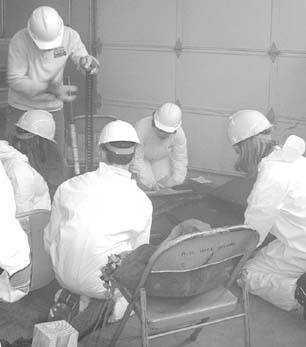Teens get disaster training

A small group of Mountain Home High School students spent their weekend preparing for a disaster. The teenagers were the first youth group in the state to participate in the Community Emergency Response Team (CERT) training program.
Deputy Nick Schilz, head of Elmore County's disaster services, Chief Phil Gridley with the Mountain Home Fire Department, and Jim Nolan, with the county's search and rescue team, teamed up to serve as instructors during the two days of training.
Schilz explained the importance of disaster preparedness. During the excitement created by an emergency, with adrenaline rushing, it can be hard to focus on anything but the immediate situation. Training and practice can make lifesaving skills become almost second nature.
Fire extinguishers are readily available in most buildings and many people carry them in their vehicles. But few people have ever actually used an extinguisher. Chief Gridley noted extinguishers are good for small fires, can help prevent additional fires, and can be used to assist with evacuation where necessary. Each of the students had an opportunity to use an extinguisher during the training session.
Nolan provided tips for searching for victims and explained the importance of caution when trying to rescue a victim. Cribbing (braces to prevent slipping) may be needed to help support debris if a victim is trapped. Students practiced setting the cribbing to slowly but steadily raise obstacles.
A mock disaster on the final day of the training allowed a hands-on experience to put their lessons to use.
Imagine. There has been an earthquake with an epicenter northeast of Mountain Home. A short distance away structures shook from the earth's tremors. Furnishings and equipment fall. Inside, a maintenance person has been trapped under fallen debris. A small fire has broken out and the injured victim lies helpless.
The ten students were the first to respond at the scene and quickly assessed the situation. Three young people became firefighters, knocking down the flames with fire extinguishers. As soon as they had determined the blaze to be extinguished, search and rescue operations could begin. Heavy smoke combined with the fallen debris inside of the building to create a challenge for rescuers trying to locate the victim.
While the rescue unit worked to lift the heavy debris to free the injured woman, the medical team evaluated her medical needs. Students learned to quickly improvise when necessary. Cribbing strips served as splints to immobilize a broken arm and leg.
With the rescue complete, the students entered another important phase of their mission -- debriefing. Students took the opportunity to look back at their strengths and weaknesses during the exercise, to see what worked best for them as well as to contemplate what they might have done differently.
Organizers of the program hope the students can now share some of their experience with others, maybe even helping to train future CERT groups.
